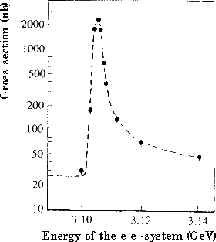
Samuel Ting and his coworkers studied the production of electron positron pairs in proton proton collisions. When the mass of the produced e+e- system was 3097 MeV the number of registered reactions ("events") was much higher than expected. The distribution of the number of events as a function of the mass of the e+e- system showed a clear peak at the mass 3097 MeV. They called the new and, at that time, the heaviest known particle J.

Burton Richter and his coworkers studied production of hadrons. When the energy of the electron- and positron beam was 1.55 GeV, the probability of hadron production increased by a factor of a hundred. The distribution of the number of events showed a clear peak when the energy of the e+e- system was 3.1 GeV. They called the new particle Y.

[home] [quarks] [leptons] [forces] [inside matter]